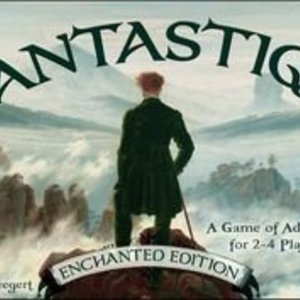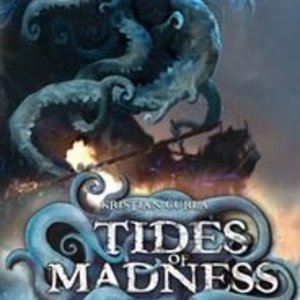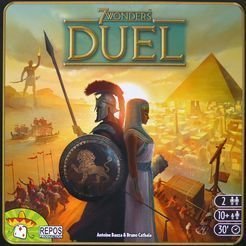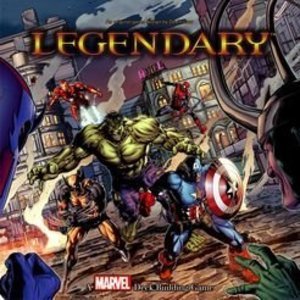Search
Search results
Purple Phoenix Games (2266 KP) rated Cartooner: The Fast & Furious Game of Drawing Comics in Tabletop Games
Jul 23, 2019
Ok, I need to admit to you all that I am an artist. I am a musician (as we all at Purple Phoenix Games are). Unfortunately, I am nowhere near what anyone would call a competent visual artist (see play pic below for evidence of that). So when I received Cartooner from Japanime Games (thank you!) I was a bit intimidated. I was never good at Pictionary and I thought I was gonna be doomed whilst playing this. If you are like me, please keep reading because I actually did really well with this one.
A typical game of Cartooner will last four rounds and each round will be the same length – five, six, or seven minutes each. During these rounds players will create comics using increasing numbers of panels each round. So Round 1 will be a 2-panel comic, Round 2 will have 4 panels, Round 3 will have 6 panels, and the final round will contain 8 panels to fill with glorious comic gold. This is the basic game flow. Where the actual “game” part comes in is through the use of the two decks of cards.
DISCLAIMER: I do not intend to cover every single rule included in the rule book, but will describe the overall game flow and major rule set so that our readers may get a sense of how the game plays. For more in depth rules, you may purchase a copy from the publisher directly or from your FLGS. -T
Three “Theme” cards are dealt at the beginning of the game to each player, which describe the player’s obsessions. Players score points at the end of each round for including their Themes in the comic. This may sound somewhat easy, but the game comes with about 28,000 Theme cards and the combinations can be pretty wonky. For example, for my first game I was dealt Fear of Growing Old, Infidelity, and Desire to Be Famous. My 10-year old niece was dealt Aliens, Flowers, and Animals. I mean, come on! AND her dad is an art teacher (who also played with us and totally killed the art). So I thought I was beaten before we even began. The three Theme cards kept everyone pretty busy in Round 1, but it was about to get harder.
Round 2 introduces a new element to the game that refreshes every round: “Trend” cards. Whomever scored lowest in the previous round will draw Trend cards (the number of which is determined by which round you are currently playing) and choose cards to enact for the upcoming round. Trends are basically bonus cards that you can attempt to incorporate into your comic for the round to score fabulous amounts of points. These are optional, of course, but really can boost those scores for the round, so are not to be ignored.
At the end of each round players will present and read their comics to the group to be scored. Points are awarded for including your Themes, completing objectives from the Trend cards, and also for filling in every panel on your page – which I thought would be a breeze, but apparently eight panels is way too hard for me because I neglected to draw something in the final two panels. Tally up your points from all the rounds and determine the greatest comic artist at the table (it was me)!
Components. This game is a large pad of paper, 28,000 cards, and cardboard VP tokens. You must supply your own writing utensil. As you can see below, I like to live on the edge and used ballpoint pen for my artwork. The tokens are fine and the cards are of good quality. What I really want to highlight is the pad of paper that is provided. Every game each player will need four sheets of paper from the pad, one for each round. These pages are wonderfully organized and include the game rules at the bottom of each page to remind you of what will score points. This helps you to prioritize your panels to include the most VP-worthy elements and to (hopefully) tell a good story as well.
All in all this is a frantic comic drawing game that will have you pulling out your hair trying to compose a somewhat cohesive short visual story including elements that may not, and probably WILL not, fit into that narrative. It is relatively quick, as long as the presentations and arbitrations are held in check for time. We do not have many drawing games in our collections, and I am overjoyed that we now have an enjoyable representative of the genre. Purple Phoenix Games eagerly awards this one a 10/12. Go check it out and test your own illustration skills.
A typical game of Cartooner will last four rounds and each round will be the same length – five, six, or seven minutes each. During these rounds players will create comics using increasing numbers of panels each round. So Round 1 will be a 2-panel comic, Round 2 will have 4 panels, Round 3 will have 6 panels, and the final round will contain 8 panels to fill with glorious comic gold. This is the basic game flow. Where the actual “game” part comes in is through the use of the two decks of cards.
DISCLAIMER: I do not intend to cover every single rule included in the rule book, but will describe the overall game flow and major rule set so that our readers may get a sense of how the game plays. For more in depth rules, you may purchase a copy from the publisher directly or from your FLGS. -T
Three “Theme” cards are dealt at the beginning of the game to each player, which describe the player’s obsessions. Players score points at the end of each round for including their Themes in the comic. This may sound somewhat easy, but the game comes with about 28,000 Theme cards and the combinations can be pretty wonky. For example, for my first game I was dealt Fear of Growing Old, Infidelity, and Desire to Be Famous. My 10-year old niece was dealt Aliens, Flowers, and Animals. I mean, come on! AND her dad is an art teacher (who also played with us and totally killed the art). So I thought I was beaten before we even began. The three Theme cards kept everyone pretty busy in Round 1, but it was about to get harder.
Round 2 introduces a new element to the game that refreshes every round: “Trend” cards. Whomever scored lowest in the previous round will draw Trend cards (the number of which is determined by which round you are currently playing) and choose cards to enact for the upcoming round. Trends are basically bonus cards that you can attempt to incorporate into your comic for the round to score fabulous amounts of points. These are optional, of course, but really can boost those scores for the round, so are not to be ignored.
At the end of each round players will present and read their comics to the group to be scored. Points are awarded for including your Themes, completing objectives from the Trend cards, and also for filling in every panel on your page – which I thought would be a breeze, but apparently eight panels is way too hard for me because I neglected to draw something in the final two panels. Tally up your points from all the rounds and determine the greatest comic artist at the table (it was me)!
Components. This game is a large pad of paper, 28,000 cards, and cardboard VP tokens. You must supply your own writing utensil. As you can see below, I like to live on the edge and used ballpoint pen for my artwork. The tokens are fine and the cards are of good quality. What I really want to highlight is the pad of paper that is provided. Every game each player will need four sheets of paper from the pad, one for each round. These pages are wonderfully organized and include the game rules at the bottom of each page to remind you of what will score points. This helps you to prioritize your panels to include the most VP-worthy elements and to (hopefully) tell a good story as well.
All in all this is a frantic comic drawing game that will have you pulling out your hair trying to compose a somewhat cohesive short visual story including elements that may not, and probably WILL not, fit into that narrative. It is relatively quick, as long as the presentations and arbitrations are held in check for time. We do not have many drawing games in our collections, and I am overjoyed that we now have an enjoyable representative of the genre. Purple Phoenix Games eagerly awards this one a 10/12. Go check it out and test your own illustration skills.
Purple Phoenix Games (2266 KP) rated Fantastiqa in Tabletop Games
Jul 30, 2021
Ahh yes, Fantastiqa. Another to add to the list of, “I once owned, then I got rid of it, then missed it so much I had to reacquire it.” My wife loves when I do that… In any case, Fantastiqa gives players a very strange slant on deck building adventure games. Some would say the theme and its implementation will make or break it for players. Upon which side of the line do we fall?
Fantastiqa is a fantasy rock-paper-scissors style deck building adventure game. Now each of those mechanics individually can make for a wonderful children’s game. Looking upon the art in Fantastiqa will also nudge players towards that of a children’s game. Alas, Fantastiqa is not a children’s game and players will be scratching their heads for multiple reasons whilst playing it.
To setup, follow the instructions of the rulebook. There are just too many to list and explain here. Once setup, the game should look something like the photo above. Each player will have their draw decks identical to those of their opponents, and the play area is essentially a map of six locations with a statue at each location and decks of cards from which players will be drawing on their turns.
A typical turn will allow players to complete one of three different actions: Go Adventuring (where players will be using cards from their decks to subdue and recruit creatures between locations), Visit a Statue (where players can draw cards from the different decks for Beast, Artifact, and Quest cards to add to their discard piles, or pay gems to exile cards from their hands out of the game, or even pay gems to teleport to the matching statue on the other side of the board), or Complete a Quest (by discarding their appropriate cards that fulfill the quest requirements).
Turns can be very quick, or long and drawn out as players carefully choose which tactics to apply to the board on the table, while weighing the need for more powerful cards in their decks, and keeping up with the Joneses as they compete for VP on Quest cards. This is a deck builder, after all, so improving one’s deck is always the first consideration, but should a player oust those dang tea-drinking lazy dragon cards, or attempt to commit cards to a quest? The choices are quite numerous as play continues, and players realize that, again, this is no child’s game. Play continues in this fashion of players taking turns completing actions and quests until one player gains enough VP through completed quests to win the game.
Components. Every component in Fantastiqa is Fantastiq! I feel like the entire game is linen-finished, save for the little plastic gems and large statueeples. This game feels quite deluxe, and that will always be a big stamp of approval from me. One thing that can jar some players is the choice of art used between the player placards, card art, token art, and other components. They certainly don’t match at all, but I believe this tracks with the quirky nature of the theme and game overall, so I quite enjoy it. I can indeed understand why some would be opposed, but that is not how I feel at all.
I kinda bled into my final thoughts there, but I do love Fantastiqa. The theme is super weird: players answer a Help Wanted ad and long story short they meet a crazy old man who gives them a rucksack full of ordinary items: toothbrush, helmet, bat, and a dog. The dog runs away across the street and players find themselves in another world where these ordinary items are now transformed into magic wands, rams (the animals), clubs, and a dog, among other items. Players I have played with cannot accept that a spatula is a sword in the game and that just breaks immersion for them. I quite like it and the game’s wacky theme.
But the gameplay itself is also quite engaging. Traveling all over this new world subduing (and subsequently recruiting to your cause) Knights with spatulae and Giant Spiders with cat’s teeth is interesting and a fresh way to incorporate a theme into a deck builder as opposed to simply generating purchasing power and buying the cards that are wanted. The statue interactions are great ways to build up your deck as well, and keeping an eye on what quests others are gunning for as well as their personal hidden quests adds a bit of race-game feeling that some other deck builders lack. I can’t say enough great things about Fantastiqa, but completely understand how the theme may break the game for others’ enjoyment. That said, Purple Phoenix Games give this one a well-traveled 10 / 12. It’s weird, I’ll give you that, but it’s a good kind of weird. Check it out.
Fantastiqa is a fantasy rock-paper-scissors style deck building adventure game. Now each of those mechanics individually can make for a wonderful children’s game. Looking upon the art in Fantastiqa will also nudge players towards that of a children’s game. Alas, Fantastiqa is not a children’s game and players will be scratching their heads for multiple reasons whilst playing it.
To setup, follow the instructions of the rulebook. There are just too many to list and explain here. Once setup, the game should look something like the photo above. Each player will have their draw decks identical to those of their opponents, and the play area is essentially a map of six locations with a statue at each location and decks of cards from which players will be drawing on their turns.
A typical turn will allow players to complete one of three different actions: Go Adventuring (where players will be using cards from their decks to subdue and recruit creatures between locations), Visit a Statue (where players can draw cards from the different decks for Beast, Artifact, and Quest cards to add to their discard piles, or pay gems to exile cards from their hands out of the game, or even pay gems to teleport to the matching statue on the other side of the board), or Complete a Quest (by discarding their appropriate cards that fulfill the quest requirements).
Turns can be very quick, or long and drawn out as players carefully choose which tactics to apply to the board on the table, while weighing the need for more powerful cards in their decks, and keeping up with the Joneses as they compete for VP on Quest cards. This is a deck builder, after all, so improving one’s deck is always the first consideration, but should a player oust those dang tea-drinking lazy dragon cards, or attempt to commit cards to a quest? The choices are quite numerous as play continues, and players realize that, again, this is no child’s game. Play continues in this fashion of players taking turns completing actions and quests until one player gains enough VP through completed quests to win the game.
Components. Every component in Fantastiqa is Fantastiq! I feel like the entire game is linen-finished, save for the little plastic gems and large statueeples. This game feels quite deluxe, and that will always be a big stamp of approval from me. One thing that can jar some players is the choice of art used between the player placards, card art, token art, and other components. They certainly don’t match at all, but I believe this tracks with the quirky nature of the theme and game overall, so I quite enjoy it. I can indeed understand why some would be opposed, but that is not how I feel at all.
I kinda bled into my final thoughts there, but I do love Fantastiqa. The theme is super weird: players answer a Help Wanted ad and long story short they meet a crazy old man who gives them a rucksack full of ordinary items: toothbrush, helmet, bat, and a dog. The dog runs away across the street and players find themselves in another world where these ordinary items are now transformed into magic wands, rams (the animals), clubs, and a dog, among other items. Players I have played with cannot accept that a spatula is a sword in the game and that just breaks immersion for them. I quite like it and the game’s wacky theme.
But the gameplay itself is also quite engaging. Traveling all over this new world subduing (and subsequently recruiting to your cause) Knights with spatulae and Giant Spiders with cat’s teeth is interesting and a fresh way to incorporate a theme into a deck builder as opposed to simply generating purchasing power and buying the cards that are wanted. The statue interactions are great ways to build up your deck as well, and keeping an eye on what quests others are gunning for as well as their personal hidden quests adds a bit of race-game feeling that some other deck builders lack. I can’t say enough great things about Fantastiqa, but completely understand how the theme may break the game for others’ enjoyment. That said, Purple Phoenix Games give this one a well-traveled 10 / 12. It’s weird, I’ll give you that, but it’s a good kind of weird. Check it out.
Purple Phoenix Games (2266 KP) rated Agropolis in Tabletop Games
Sep 24, 2020
Being based on the Iowa/Illinois border, Purple Phoenix Games is definitely headquartered in the good ol’ Midwest. We are not without cities and modern amenities, as some might suspect, but we are certainly accustomed to seeing farm life, rural communities, and rolling fields of crops. Figuring out how exactly to organize your fields and crops is no easy task, and Agropolis is here to put you to the test!
Disclaimer: We were provided a copy of Agropolis for the purposes of this preview. The components are not yet finalized, and will probably change from what you see here to the finished Kickstarter campaign. Agropolis is a stand-alone expansion to the popular ButtonShy title, Sprawlopolis. We have reviewed Sprawlopolis (as both a Solo Chronicles, as well as Multiplayer) in the past, so I do not intend to rehash the entire ruleset in this preview. -L
In Agropolis, players are working cooperatively to create a cohesive and thriving rural community. The overall gameplay is the same as Sprawlopolis, with a few thematic differences. To begin the game, randomly select 3 cards to dictate the scoring conditions for your specific game. Deal 1 card to each player (3 to the starting player), and place one card face-up in the center of the table. On your turn, you will draw a card, play a card into the communal countryside, pass your remaining cards to the next player, and then draw a new card. The goal is to create a countryside that scores enough points to surpass the combined total of the 3 scoring condition cards.
Each card is divided into four zones: cornfields, livestock pens, orchards, and vineyards. The selected scoring condition cards determine how you can earn and lose points for your card/zone placements in the countryside. That’s where strategy comes into play – you can’t just place your cards wherever you want! There has to be a method to the madness, and each placement must be carefully selected for maximum end-game points. When all cards have been played, tally up your points – earning points for each zone, gaining/losing points for scoring conditions, and deducting points for roads. If your final score is higher than the total of the 3 scoring conditions combined, then you have won!
As a big fan of Sprawlopolis, I am happy to report that ButtonShy has done it again with Agropolis. The overall gameplay and atmosphere is the same between both games, which adds a comfort and familiarity to the game, but the thematic differences and scoring conditions make the game feel subtly unique. Aside from a country theme, Agropolis has an optional challenge known as the Feed Fee. Certain cards have a feedbag and livestock symbol underneath the card’s score, and all cards have a combination of livestock symbols at the bottom of the scoring description. To play with the Feed Fee, simply count the number of that specific type of livestock across all 3 scoring condition cards and add that to your scoring total. You might even have multiple Feed Fees in play for a single game! That is a new added challenge unique to Agropolis, and can really up the ante of the gameplay.
Our preview copy of Agropolis also came with a 6-card combo pack expansion that allows you to combine both Agropolis and Sprawlopolis into one big game. To play with the combo pack, randomly select one scoring condition card from the three decks: Agropolis, Sprawlopolis, and the combo pack. Randomly select another combo pack card to be the starting card of your city/country blended community. On your turn, you will draw 1 Agropolis card and 1 Sprawlopolis card. Play only one of those cards to the tableau, and the other is discarded. When both draw decks run out, the game is over and points are tallied. This combo game is uniquely challenging because you have scoring conditions from both games. You can’t focus on the city-side and let the country peter out, because at least one of the scoring condition cards calls for a country-specific goal. This combo pack takes the simplicity of both games and really ups the amount of strategy required for success. Definitely a combo I will be playing a lot!
All in all, how is Agropolis? The gameplay itself is simple, strategic, and satisfying to play. Although nearly identical to Sprawlopolis, the thematic differences and country-specific scoring conditions make the game feel new and refreshing. I absolutely love the 6-card combo pack to combine both games together. It just heightens the gameplay and strategic considerations, and takes it from a smaller game to something with a little more heft. Some people are all about that city life, but I think Agropolis will show you the beauty of the rural community. Be sure to check out the Kickstarter campaign, going live on Tuesday, September 29th!
Disclaimer: We were provided a copy of Agropolis for the purposes of this preview. The components are not yet finalized, and will probably change from what you see here to the finished Kickstarter campaign. Agropolis is a stand-alone expansion to the popular ButtonShy title, Sprawlopolis. We have reviewed Sprawlopolis (as both a Solo Chronicles, as well as Multiplayer) in the past, so I do not intend to rehash the entire ruleset in this preview. -L
In Agropolis, players are working cooperatively to create a cohesive and thriving rural community. The overall gameplay is the same as Sprawlopolis, with a few thematic differences. To begin the game, randomly select 3 cards to dictate the scoring conditions for your specific game. Deal 1 card to each player (3 to the starting player), and place one card face-up in the center of the table. On your turn, you will draw a card, play a card into the communal countryside, pass your remaining cards to the next player, and then draw a new card. The goal is to create a countryside that scores enough points to surpass the combined total of the 3 scoring condition cards.
Each card is divided into four zones: cornfields, livestock pens, orchards, and vineyards. The selected scoring condition cards determine how you can earn and lose points for your card/zone placements in the countryside. That’s where strategy comes into play – you can’t just place your cards wherever you want! There has to be a method to the madness, and each placement must be carefully selected for maximum end-game points. When all cards have been played, tally up your points – earning points for each zone, gaining/losing points for scoring conditions, and deducting points for roads. If your final score is higher than the total of the 3 scoring conditions combined, then you have won!
As a big fan of Sprawlopolis, I am happy to report that ButtonShy has done it again with Agropolis. The overall gameplay and atmosphere is the same between both games, which adds a comfort and familiarity to the game, but the thematic differences and scoring conditions make the game feel subtly unique. Aside from a country theme, Agropolis has an optional challenge known as the Feed Fee. Certain cards have a feedbag and livestock symbol underneath the card’s score, and all cards have a combination of livestock symbols at the bottom of the scoring description. To play with the Feed Fee, simply count the number of that specific type of livestock across all 3 scoring condition cards and add that to your scoring total. You might even have multiple Feed Fees in play for a single game! That is a new added challenge unique to Agropolis, and can really up the ante of the gameplay.
Our preview copy of Agropolis also came with a 6-card combo pack expansion that allows you to combine both Agropolis and Sprawlopolis into one big game. To play with the combo pack, randomly select one scoring condition card from the three decks: Agropolis, Sprawlopolis, and the combo pack. Randomly select another combo pack card to be the starting card of your city/country blended community. On your turn, you will draw 1 Agropolis card and 1 Sprawlopolis card. Play only one of those cards to the tableau, and the other is discarded. When both draw decks run out, the game is over and points are tallied. This combo game is uniquely challenging because you have scoring conditions from both games. You can’t focus on the city-side and let the country peter out, because at least one of the scoring condition cards calls for a country-specific goal. This combo pack takes the simplicity of both games and really ups the amount of strategy required for success. Definitely a combo I will be playing a lot!
All in all, how is Agropolis? The gameplay itself is simple, strategic, and satisfying to play. Although nearly identical to Sprawlopolis, the thematic differences and country-specific scoring conditions make the game feel new and refreshing. I absolutely love the 6-card combo pack to combine both games together. It just heightens the gameplay and strategic considerations, and takes it from a smaller game to something with a little more heft. Some people are all about that city life, but I think Agropolis will show you the beauty of the rural community. Be sure to check out the Kickstarter campaign, going live on Tuesday, September 29th!
Purple Phoenix Games (2266 KP) rated Tides of Madness in Tabletop Games
Dec 7, 2021
As you know, the world of board games is quite vast – there are so many games out there, I feel like I can barely keep up! So oftentimes when I come across a game, it’s not necessarily a new one. Enter Tides of Madness. It maaaay sound familiar, and that is because it is a reimplementation of Tides of Time (which we have reviewed before). Is this just a Cthulhian re-theme of the same game, or does it alter the gameplay at all? Keep reading to find out!
Tides of Madness is a game of card drafting and set collection in which 2 players are trying to amass the most points by the end of 3 rounds. To setup for a game, shuffle the deck and deal 5 cards to each player. Place the rest aside as a draw deck, and place the Madness tokens within reach. Each of the 3 rounds is broken down into 3 phases: Drafting, Scoring, and Refresh. During the Drafting phase, each player will choose one card from their hand to keep, and place it face-down in front of them. Once both players have chosen their card, they will be revealed simultaneously and placed in your tableau. Take the remaining cards from your hand and pass them to your opponent. You now draft another card from this new hand, and will then pass the cards again. Drafting continues in this fashion until both players have no cards remaining in hand.
The next phase, Scoring, now begins. Players check their tableau and take a Madness token for each card with a Madness icon. The player with the most Madness this round can choose to gain an additional 4 VP or heal (discard) one Madness token. An important note – if at any time a player receives 9 or more Madness tokens, they immediately lose the game! So keep an eye on those cards, and know when to heal. Next, players will score the cards based on printed objectives – sets of suits, majority of a suit, etc. Points are tallied on the score pad. Finally, the Refresh phase gets you ready for the next round. Each player collects their tableau and selects one card to keep for the next round, and another card to discard from the game. Players simultaneously reveal their kept card and it starts the round already in their tableau. Players will draw 2 new cards to total 5 in hand, and the next round is ready to begin. Play ends either if a player has 9 or more Madness, or after a total of 3 rounds. After the 3rd and final round, all points are added up and the player with the highest score wins.
So if you’re thinking this game is basically Tides of Time, you’re pretty much correct. The only difference between the two is the concept/mechanic of the Madness tokens. And honestly, I think the inclusion of the tokens elevates the strategy a bit. In Tides of Time, it really is all about set collection. But with Madness tokens, you’ve got some risk/reward balance to play with. Do you take a card to complete a set even though it gives you a Madness token? Or do you leave it for last so your opponent is forced to take it? The same applies to the extra step in the Scoring phase. Do you risk keeping all your Madness to snag 4 extra VP or is it better (and safer) to heal 1? It just adds another element to the gameplay that makes it feel a little more engaging and exciting than simple set collection.
To touch on components for a minute – this game consists of 18 oversized cards, a bunch of cardboard Madness tokens, a score pad, and small pencil. The artwork on the cards is appropriately thematic and dark, and the text is clear and easy to interpret. The Madness icon on certain cards is a bunch of tentacles on the side of the card, and it is easy to see which cards are affected and which are not. The tokens and score pad are both decent quality as well. Although not 100% necessary, I appreciate the inclusion of a score pad just to help you remember points between rounds. All in all, good production all around.
I have to say that of the two, I prefer Tides of Madness over Tides of Time. You may have noticed that I have rated both games at a 4, but the Madness element in this one just pushes it over the top for me. Both are good games, don’t get me wrong! Either work as a good set collection/drafting game, and are quick to learn and play. Tides of Madness just engages me a little more and that makes the overall gameplay more enjoyable for me. So all in all, Purple Phoenix Games gives this one a maddening 4 / 6.
Tides of Madness is a game of card drafting and set collection in which 2 players are trying to amass the most points by the end of 3 rounds. To setup for a game, shuffle the deck and deal 5 cards to each player. Place the rest aside as a draw deck, and place the Madness tokens within reach. Each of the 3 rounds is broken down into 3 phases: Drafting, Scoring, and Refresh. During the Drafting phase, each player will choose one card from their hand to keep, and place it face-down in front of them. Once both players have chosen their card, they will be revealed simultaneously and placed in your tableau. Take the remaining cards from your hand and pass them to your opponent. You now draft another card from this new hand, and will then pass the cards again. Drafting continues in this fashion until both players have no cards remaining in hand.
The next phase, Scoring, now begins. Players check their tableau and take a Madness token for each card with a Madness icon. The player with the most Madness this round can choose to gain an additional 4 VP or heal (discard) one Madness token. An important note – if at any time a player receives 9 or more Madness tokens, they immediately lose the game! So keep an eye on those cards, and know when to heal. Next, players will score the cards based on printed objectives – sets of suits, majority of a suit, etc. Points are tallied on the score pad. Finally, the Refresh phase gets you ready for the next round. Each player collects their tableau and selects one card to keep for the next round, and another card to discard from the game. Players simultaneously reveal their kept card and it starts the round already in their tableau. Players will draw 2 new cards to total 5 in hand, and the next round is ready to begin. Play ends either if a player has 9 or more Madness, or after a total of 3 rounds. After the 3rd and final round, all points are added up and the player with the highest score wins.
So if you’re thinking this game is basically Tides of Time, you’re pretty much correct. The only difference between the two is the concept/mechanic of the Madness tokens. And honestly, I think the inclusion of the tokens elevates the strategy a bit. In Tides of Time, it really is all about set collection. But with Madness tokens, you’ve got some risk/reward balance to play with. Do you take a card to complete a set even though it gives you a Madness token? Or do you leave it for last so your opponent is forced to take it? The same applies to the extra step in the Scoring phase. Do you risk keeping all your Madness to snag 4 extra VP or is it better (and safer) to heal 1? It just adds another element to the gameplay that makes it feel a little more engaging and exciting than simple set collection.
To touch on components for a minute – this game consists of 18 oversized cards, a bunch of cardboard Madness tokens, a score pad, and small pencil. The artwork on the cards is appropriately thematic and dark, and the text is clear and easy to interpret. The Madness icon on certain cards is a bunch of tentacles on the side of the card, and it is easy to see which cards are affected and which are not. The tokens and score pad are both decent quality as well. Although not 100% necessary, I appreciate the inclusion of a score pad just to help you remember points between rounds. All in all, good production all around.
I have to say that of the two, I prefer Tides of Madness over Tides of Time. You may have noticed that I have rated both games at a 4, but the Madness element in this one just pushes it over the top for me. Both are good games, don’t get me wrong! Either work as a good set collection/drafting game, and are quick to learn and play. Tides of Madness just engages me a little more and that makes the overall gameplay more enjoyable for me. So all in all, Purple Phoenix Games gives this one a maddening 4 / 6.
Purple Phoenix Games (2266 KP) rated Hanamikoji in Tabletop Games
Jun 12, 2019
You own a restaurant located on Hanamikoji Street in one of Japan’s most famous Geisha districts. As a way to drum up business, you have begun to hire Geishas as entertainment for your patrons. Skilled in traditional music, dance, and art, Geishas are highly respected entertainers in Japan. However, a rival restaurateur is trying to hire the same Geishas as you! In an attempt to win the favor (and talents) of these elegant women, you begin collecting items related to their chosen art forms with the hope that these gifts will keep them at your establishment!
Hanamikoji is a 2-player game where players are competing to win the favor of the 7 Geishas. In a game of literal give-and-take played over several rounds, you and your opponent will alternate taking 4 actions to play and trade cards. The first player to win the favor of 4 Geishas, or to earn at least 11 Charm points, is the winner!
For as simple as it seems, Hanamikoji requires a lot of strategy. The cards in your hand are hidden from your opponent, but half of the actions taken each round require you to reveal cards from your hand and allow your opponent to take a certain number to their side – a traditional “I split, you choose” mechanic. You have to strategize which cards you can afford to give up, at the risk of letting your opponent win a Geisha, with the goal of winning a higher-valued Geisha instead. At the same time, your opponent will be revealing cards from their hand for you to take to your side. Your strategy is always changing based on not only the cards in your hand, but the cards that your opponent reveals to you.
One thing I really like about this game is that winning the favor of a Geisha in one round is not final. If I win a Geisha in one round, but in the next round my opponent has the majority for that specific Geisha, I lose her favor and she goes back to neutral. So not only am I trying to win over more Geishas each round, I have to actively be protecting those I have already won. The same can be said for the reverse – even if my opponent wins a Geisha in one round, I can negate that in the next round. The favor of the Geishas does not reset at the end of each round, nor is it unchangeable in future rounds. Anything can happen, and that makes for a surprisingly exciting game.
Although this is a competitive game, I find it to be kind of calming to play. It is simple, yet strategic, and the artwork is beautiful. In my experience, once you understand the gameplay and actions, it plays quickly and quietly. If you’re looking for a quality 2-player game, give Hanamikoji a try! Purple Phoenix Games rates it a graceful 10 / 12 (Bryan and Josh have not yet played it).
https://purplephoenixgames.wordpress.com/2019/02/13/hanamikoji-review/
Hanamikoji is a 2-player game where players are competing to win the favor of the 7 Geishas. In a game of literal give-and-take played over several rounds, you and your opponent will alternate taking 4 actions to play and trade cards. The first player to win the favor of 4 Geishas, or to earn at least 11 Charm points, is the winner!
For as simple as it seems, Hanamikoji requires a lot of strategy. The cards in your hand are hidden from your opponent, but half of the actions taken each round require you to reveal cards from your hand and allow your opponent to take a certain number to their side – a traditional “I split, you choose” mechanic. You have to strategize which cards you can afford to give up, at the risk of letting your opponent win a Geisha, with the goal of winning a higher-valued Geisha instead. At the same time, your opponent will be revealing cards from their hand for you to take to your side. Your strategy is always changing based on not only the cards in your hand, but the cards that your opponent reveals to you.
One thing I really like about this game is that winning the favor of a Geisha in one round is not final. If I win a Geisha in one round, but in the next round my opponent has the majority for that specific Geisha, I lose her favor and she goes back to neutral. So not only am I trying to win over more Geishas each round, I have to actively be protecting those I have already won. The same can be said for the reverse – even if my opponent wins a Geisha in one round, I can negate that in the next round. The favor of the Geishas does not reset at the end of each round, nor is it unchangeable in future rounds. Anything can happen, and that makes for a surprisingly exciting game.
Although this is a competitive game, I find it to be kind of calming to play. It is simple, yet strategic, and the artwork is beautiful. In my experience, once you understand the gameplay and actions, it plays quickly and quietly. If you’re looking for a quality 2-player game, give Hanamikoji a try! Purple Phoenix Games rates it a graceful 10 / 12 (Bryan and Josh have not yet played it).
https://purplephoenixgames.wordpress.com/2019/02/13/hanamikoji-review/

banki by Credit Agricole
Finance and Business
App
Now, with banki by Credit Agricole, the new mobile banking application, managing your accounts &...
The Marinated Meeple (1853 KP) rated 7 Wonders Duel in Tabletop Games
Apr 16, 2018
Clever two player mechanic. (2 more)
Plays quick
Luck can be mitigated slightly
Good solid 2 player game. Plays quick with good strategy.
I still love this game and skill will win 75% of games. You just need to be aware if it gets out of hand early. Like one player gets enough resources to price you out of most cards. Maybe start over and play best two out of three. If both players know the game you can play in a half hour.
Having the cards in front and selecting based on what you give the other person access to makes the strategy deeper. And building wonders is vital especially with extra turns. Which can then be used offensively or defensively. Which makes for interesting decisions too.
Great game for head to head battles.
Having the cards in front and selecting based on what you give the other person access to makes the strategy deeper. And building wonders is vital especially with extra turns. Which can then be used offensively or defensively. Which makes for interesting decisions too.
Great game for head to head battles.
Robin Gardner (8 KP) rated Legendary: A Marvel Deck Building Game in Tabletop Games
Mar 5, 2019
Theme (7 more)
Art
Rulebook
Component Quality
Replayability
Variety
Good representation of universe
Scales well
Fantastic Deckbuilder!
This game is a Marvel, scuse the pun! It is a well thought out, easy to learn deck builder which carries the theme of the Marvel Universe well. The art on the cards on the board is not only beautifully drawn, it is also exclusive to this game. You wont see it anywhere else.
The game scales well so it doesn't matter if you have 2 or 5 players, it works.
The quality of the components is good and the game comes with dividers to keep different cards separate.
Breaking down the game takes a bit of time if you want it organised for a quick set up the next time. That's the only downside I can see.
The game scales well so it doesn't matter if you have 2 or 5 players, it works.
The quality of the components is good and the game comes with dividers to keep different cards separate.
Breaking down the game takes a bit of time if you want it organised for a quick set up the next time. That's the only downside I can see.

Love
Book
A collection of Edward Monkton's highly successful Valentine's cards, collected together for the...

Pocket Mine 3
Games
App
Get on a mining adventure in this sequel to the sequel of the addictive hit game! Tap blocks to dig...






